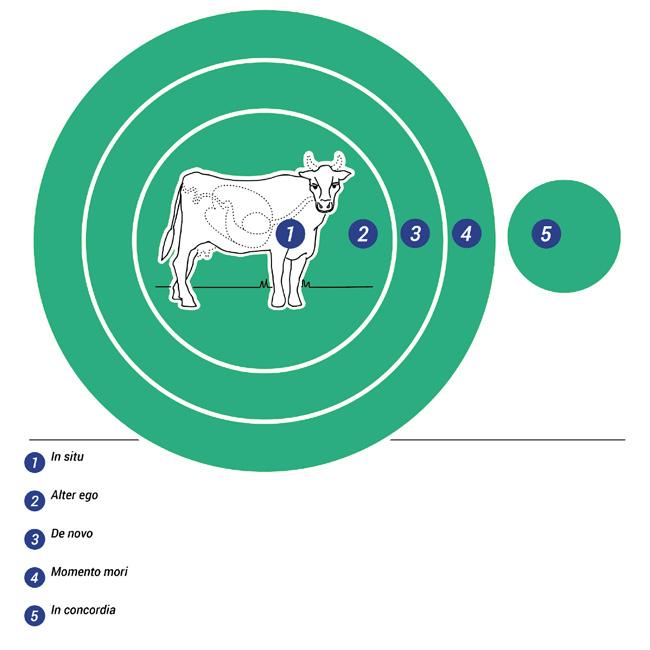
4 minute read
Yes, You Can Design a Cow Karen Ingram
Yes, You Can Designa-Cow
by Karen Ingram

How does one introduce a technology to someone right as it is being developed? That’s the question I grappled with as an Emerging Technology Fellow, focusing on synthetic biology.
What is synthetic biology? At its core, synthetic biology is focused on engineering life to collaborate productively with humans.
The work of scientists and technologists is important. Many stakeholders will not have the knowledge, vocabulary, or expertise to understand the science, but they shouldn’t have to. Through conveying this complicated information, we allow for input from those who will be affected by the science, which is imperative if we are seeking a world with more equitable technologies.
Synthetic biology is already here
There are several Genetically Modified Organisms (GMOs) on the market and in production. GMOs are a product of synthetic biology. Here are some examples:
Insulin The first commercial product to hit the market was human insulin, harvested from yeast in 1980. Traditionally, insulin was harvested from cow or pig pancreas. The process was patented by UCSF and Paul Berg at Stanford, licensed by Eli Lilly & Co, produced by Genentech, and made insulin more readily available.
Cattle In tandem with animal husbandry practices, genetic engineering techniques have been used in livestock production, for example, cows. Decades of work from researchers at UC Davis has been covered in the mainstream press and has provided us with a roller-coaster view into the regulatory hurdles involved in potentially introducing an engineered organism into the food supply for human consumption.
Chestnut Trees After a blight was introduced inadvertently in the 1800s, the American Chestnut has slowly become extinct. Geneticists at SUNY Syracuse might be close to achieving regulatory approval for an American Chestnut tree, which would make the “Darling 58” the first GMO aimed at maintaining an ecosystem.
Plant–fertilizing Microbes
Plants like soybeans and peas contain microbes in their roots that naturally fertilize them through a process called “nitrogen fixation.” This negates the need to use costly nitrogen-based fertilizers, which contaminate waterways and cause greenhouse gasses. Companies are providing solutions that encourage microbes living in the roots of cereal crops like corn to produce the same effects.
Bt Crops
Several crops on the market, including corn, cotton, potatoes, and eggplant contain genes from the bacterium Bacillus thuringiensis (Bt). These genes produce a natural pesticide, reducing the usage of chemical pesticides. Bt crops are being planted by farmers around the world, including farmers in the U.S., South Africa, The Philippines, and Bangladesh, and Bt crop regulatory approval is pending in many more countries.
Plants as Biofoundries
The basic research conducted by The Patron Group, at the Earlham Institute in Norwich, UK is focused on exploring the plant Nicotiana benthamiana as a platform for sustainable biomanufacturing of useful chemical compounds. The plants could be used to produce compounds for medicines, but also for pest control. Introducing Synbio With a Design Activity Looking at cows as an example; what do we value about them? What could we potentially change? It’s important to open up the design space to allow students to move away from the obvious. We may not want to change a cow, but we might want to enjoy a burger. Perhaps we should investigate making changes “de novo” (see opposite) and exploring the technology used to produce meat without cows. In the first synthetic biology design exercise, students both design their own cow and wrestle with the implications, positive and negative, that might arise from bringing it to life.
The learning experience is open-ended, and encourages creative thinking; there’s no right or wrong answer. Students can postulate on what might be feasible vs. what’s difficult; what’s fantastic and what’s pretty ordinary. The very real ambiguity of designing with biology abounds.
Through critique and feedback, Design-aCow and other synthetic biology design exercises are meant to pique curiosity and inspire questions. Emerging technologies impact us all, and it is through engagement and query that we can embark on making technologies that work for, and represent all of us.
The cow, or any of its products

Another self; a change in how we typically think of cows
Other sources that could create the valued products a cow makes
Bring back or preserve wild animals similar to cows, or bring back valuable traits that no longer exist in a cow's genome
Things that a cow interacts with, or is dependant on, that could be modified
























